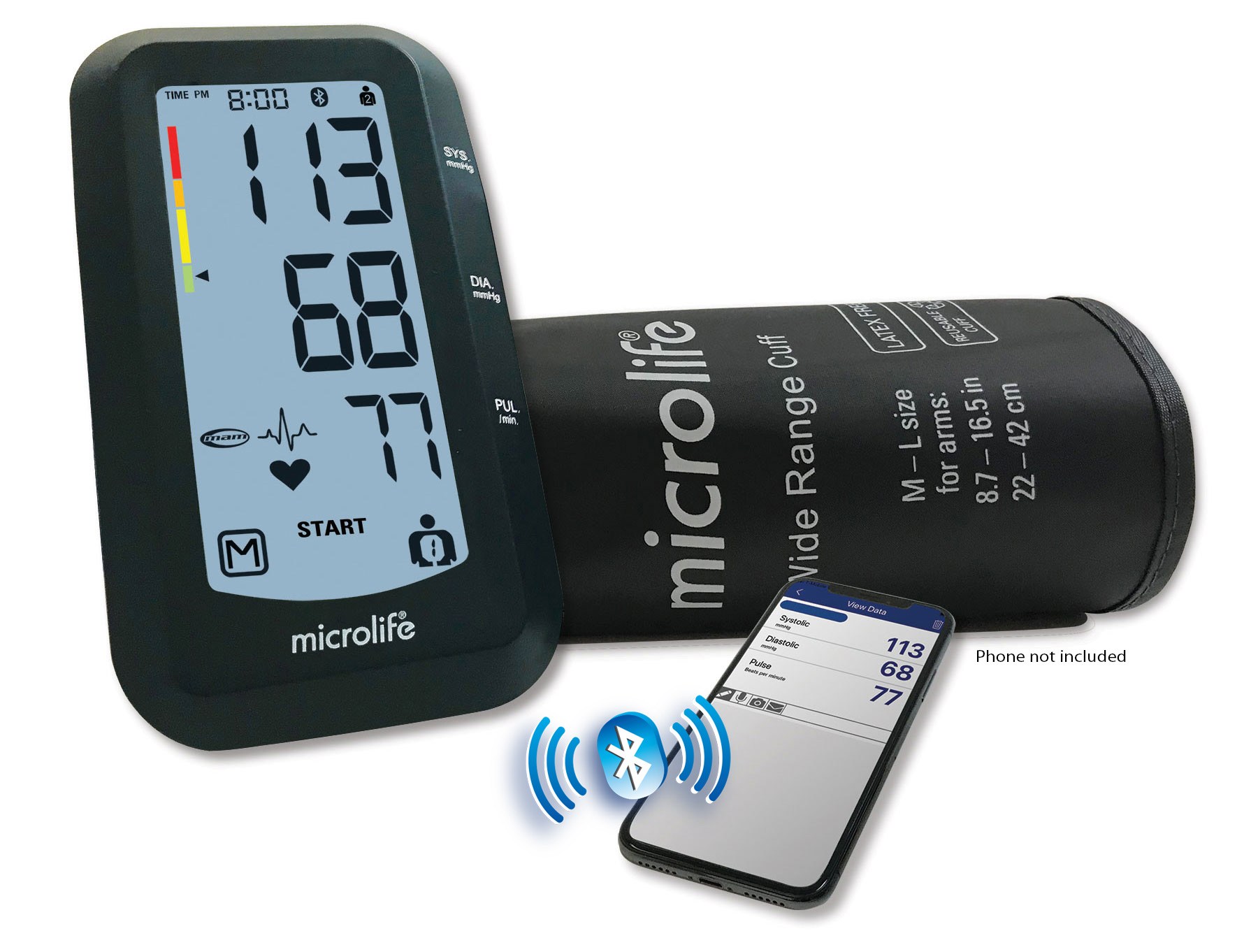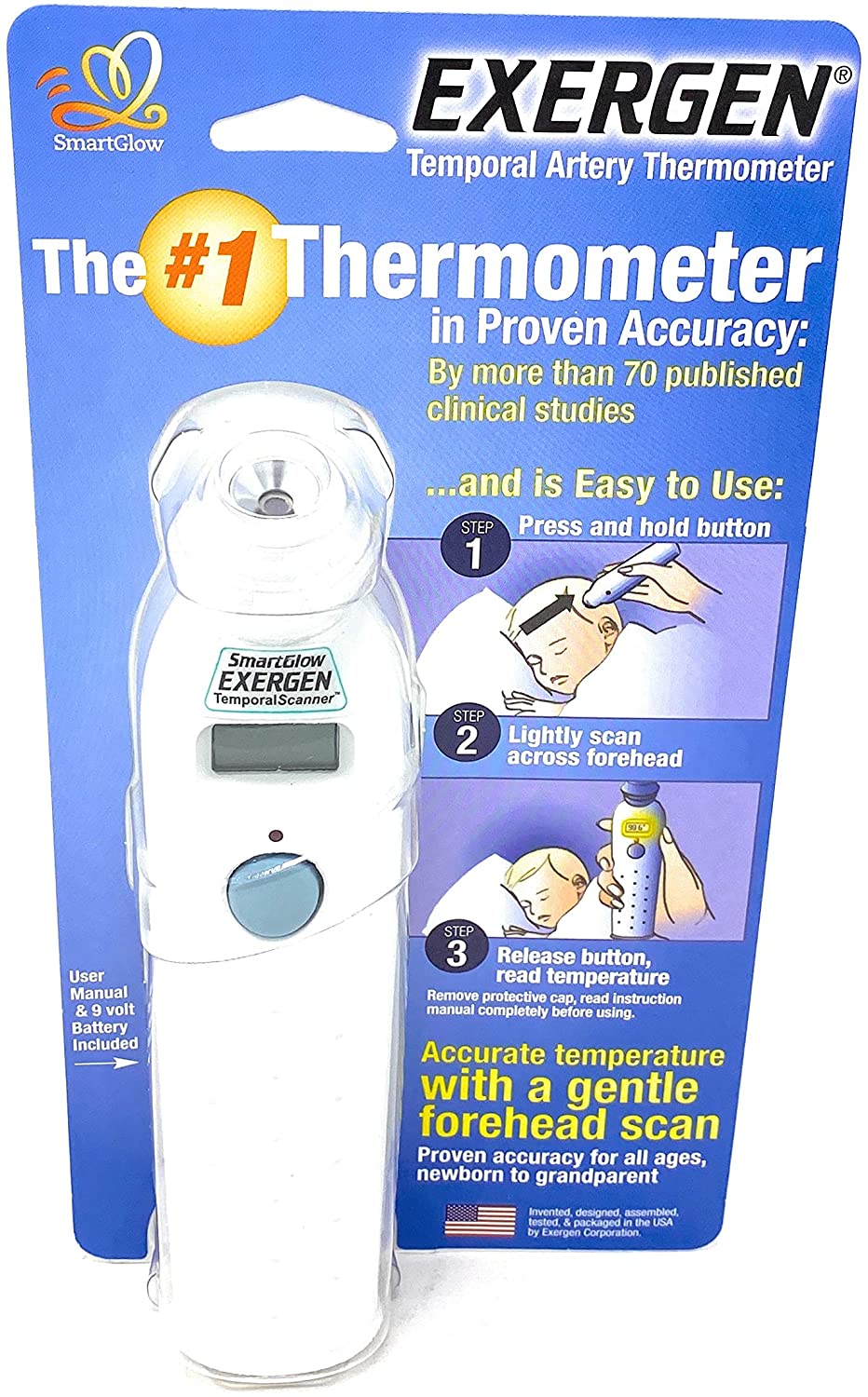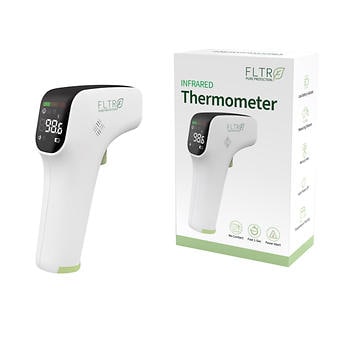Microlife Bluetooth Upper Arm Blood Pressure Monitor with Irregular Heartbeat Detection
Microlife Bluetooth Upper Arm Blood Pressure Monitor with Irregular Heartbeat Detection
Jinne Store
Take Control of Your Heart Health!
MEDICAL GRADE ACCURACY
Nothing is more important in a blood pressure monitor than accuracy. Microlife’s blood pressure monitors are clinically tested and have been independently validated as having the highest possible accuracy (A/A) by the British Hypertension Society, the leading institution for testing monitors.
Cardiologists recommend the use of home blood pressure monitors, in conjunction with your physician’s care, as a simple and effective way to help manage hypertension.
Microlife’s blood pressure monitors help by delivering medical grade accuracy, quality, and ease of use that allow you to take control of your health.
BLUETOOTH® CONNECTIVITY & FREE MICROLIFE HEALTH APP
You can wirelessly sync, track and email your readings to your doctor with ease using a smart device. Microlife’s Connected Health App gives you a clear overview of your blood pressure readings over time.
Note: This monitor functions normally without the Microlife Health App or Bluetooth® connectivity. Phone not included.
HEALTH APP FEATURES
Compatible with Apple™ or Android™ smartphones
Sync readings automatically from your monitor to your phone
Record your readings
Email individual or all readings
View Morning, Evening or 24-hour averages
Link comments (text & voice and photos) to a reading
Simple & easy to use
Before you begin
To ensure an accurate reading, follow these steps before you begin a measurement:
Sit quietly for 5 minutes.
Avoid eating, smoking or any form of exertion.
Do not flex muscles during your measurement.
Always measure using the same arm, at the same time of day.
Easy as 1..2..3!
To measure blood pressure and pulse:
Make sure the cuff tube is securely connected to the monitor.
Slide arm through cuff as shown on bare skin until the bottom edge is ½" above elbow. Align artery mark and tubing to brachial artery (inner arm). Cuff fits biceps 8.7" – 16.5".
Adjust the cuff until it is snug against your arm, but not too tight. You should be able to fit 2 fingers between cuff and arm.
Sit and rest for 5 minutes prior to measurement. Relax your arm and push the start button.
How can I ensure an accurate measurement?
There are simple steps you can take to ensure an accurate measurement. Even seemingly small things can raise your readings. Follow these steps to ensure an accurate measurement:
Always measure using the same arm, at the same time of day.
Avoid eating, tobacco or any form of exertion before you take your measurement.
Make sure your bladder is empty. A full bladder can increase systolic pressure by 10-15 mmHg.
Ensure clothing does not interfere with the cuff. A cuff over clothing can raise systolic pressure by 40 mmHg.
Sit quietly at a table with both feet flat on the floor, avoiding movement and talking during a measurement. Talking can raise systolic pressure by 10-15 mmHg.
Typical fluctuations in blood pressure
Blood Pressure is constantly fluctuating throughout the day. It is important to measure your blood pressure at the same times each day to more accurately monitor your readings. Your blood pressure varies greatly on a daily and seasonal basis. It changes throughout one's lifetime. It is not uncommon for systolic pressure to vary by 40 mmHg or more throughout the course of a single day!
While generally not as volatile, diastolic pressure can still vary significantly. In hypertensive individuals, variations are even more pronounced. Normally, blood pressure is at its lowest during sleep and rises in the morning and throughout the day. The chart illustrates the fluctuations that could occur in a typical day.
What is hypertension?
Hypertension, or high blood pressure, is a chronic medical condition in which the blood pressure in the arteries is elevated. The level of blood pressure is established by a part of the brain known as the circulatory center and is regulated by feedback from the central nervous system. It is adjusted by the strength and frequency of the heart rate (pulse) and by the width of the blood vessel walls. The level of arterial blood pressure changes periodically during heart activity:
During the "blood ejection" (systole) stage, the value is maximal and referred to as the systolic blood pressure value, while at the end of heart's "rest period" (diastole), the value is minimal and referred to as the diastolic blood pressure value. The blood pressure values must lie within certain normal ranges in order to prevent particular diseases.
New Blood Pressure Standards
With an eye towards improving public health, the American Heart Association (AHA) and the American College of Cardiology (ACC) revised the hypertension threshold to 130/80 mmHg (for adults) in 2017. This change in blood pressure guidelines is intended to provide early notification for those with elevated numbers, so that they may better manage their health.
As with all medical treatment, managing hypertension, medication, and any lifestyle changes, should be discussed with a physician.
What do my blood pressure numbers mean?
Blood pressure is determined by the circulatory center in the brain and is made up of two numbers:
Systolic (the first number): shows how much pressure the blood is exerting against the artery walls as the heart contracts (pumps).
Diastolic (the second number): shows how much pressure the blood is exerting against the artery walls while the heart rests (between beats). In addition to blood pressure, it's important to monitor the pulse, or the number of times a heart beats in a minute.
Hypertension & Diabetes, why it matters
What does diabetes have to do with hypertension?
• Almost 80% of all diabetics are hypertensive
• Blood pressure for diabetics can be hard to monitor with accuracy
With diabetes, arteries will stiffen and harden over time, making it more difficult to obtain accurate blood pressure readings.
Clinical accuracy with diabetes
• Microlife monitors are clinically validated accurate with diabetes
Microlife’s commitment to health has led to a breakthrough clinical validation for accurate readings in the presence of diabetes. Now everyone, including diabetics, can rest assured that their blood pressure is accurately measured, which can help them manage their health.
I’m not a diabetic, is this monitor for me?
Yes. This monitor has been clinically proven with A/A accuracy, the gold standard for measuring accuracy in blood pressure monitors. So, whether you have diabetes or not, you can rest assured that you will get an accurate read.
Note: this monitor does not measure blood glucose.
A/A Accuracy: highest possible accuracy given by the British Hypertension Society, the leading institution for testing blood pressure monitors.
Q: How can I tell if my blood pressure monitor is accurate?
A: The technology used in your new blood pressure monitor meets the highest clinical standards of the British Hypertension Society and American Association for the Advancement of Medical Instrumentation (AAMI). When used correctly, this monitor will provide readings comparable to those taken in your doctor’s office.
Q: Does my blood pressure monitor need to be calibrated?
A: Each time you power on this monitor, it runs a self-calibration check (signaled by the quick flashes of "OK" on the display). In addition, we recommend having the monitor checked for accuracy every two years. To have your blood pressure monitor's accuracy verified, please call customer support at 1-800-568-4147 (Mon-Fri 8am to 8pm, eastern).
Q: Can I use rechargeable batteries with this monitor?
A: No. Microlife does not recommend the use of rechargeable batteries.
Q: Is this blood pressure cuff latex-free?
A: Yes.
Q: Can I take my blood pressure measurement on my left OR right arm?
A: Yes - this monitor will work with either arm. However, please note that pressures are typically different between the left and right arm, so it's important to always measure using the same arm.
Q: Why are my blood pressure readings higher or lower than at my doctor’s office?
A: Many people experience what is called “White Coat Hypertension” when having blood pressure measured by a doctor or clinician. Discuss the possibility of White Coat Hypertension with your doctor. Also note normal pressure fluctuations throughout the day.
Q: My blood pressure varies throughout the day. How do I know which is my true blood pressure?
A: The average of several results, obtained over several days under comparable conditions, represents your individual blood pressure. It is important to measure your blood pressure consistently and regularly to better manage your heart health.
Q: Can I use this blood pressure monitor during pregnancy?
A: No, this Microlife monitor has not been validated for use under special conditions such as preeclampsia (hypertension during pregnancy).
Q: Is a larger cuff available?
A: The cuff included with the monitor is sized M-L (8.7 - 16.5"). A larger size (L-XL, 12.6 - 20.5") is available by calling customer support at 1-800-568-4147 (Mon-Fri 8am to 8pm, eastern).
Q: Does this blood pressure blood pressure monitor pair the same way as other Bluetooth devices?
A: No, this monitor has a unique HIPAA compliant pairing process. Please make sure you follow the pairing instructions in the user manual. For best results using the Microlife Connected Health App, please ensure the following before syncing with your smartphone:
Time and date were set on the monitor prior to taking a reading
The monitor has at least one reading saved in its memory
The correct user is selected on the monitor
Details
microlife blood pressure monitor , Take Control of Your Heart Health! MEDICAL GRADE ACCURACY Nothing is more important in a blood pressure monitor than accuracy. Microlife’s blood pressure monitors are clinically tested and have been independently validated as having the highest possible accuracy (A/A) by the British Hypertension Society, the leading institution for testing monitors. Cardiologists recommend the use of home blood pressure monitors, in conjunction with your physician’s care, as a simple and effective way to help manage hypertension , microlife blood pressure machines for home use , Microlife’s blood pressure monitors help by delivering medical grade accuracy, quality, and ease of use that allow you to take control of your health. BLUETOOTH® CONNECTIVITY & FREE MICROLIFE HEALTH APP You can wirelessly sync, track and email your readings to your doctor with ease using a smart device. Microlife’s Connected Health App gives you a clear overview of your blood pressure readings over time. Note: This monitor functions normally without the Microlife Health App or Bluetooth® connectivity. Phone not included. HEALTH APP FEATURES Compatible with Apple™ or Android™ smartphones Sync readings automatically from your monitor to your phone Record your readings Email individual or all readings View Morning, Evening or 24-hour averages Link comments (text & voice and photos) to a reading Simple & easy to use Before you begin To ensure an accurate reading, follow these steps before you begin a measurement: Sit quietly for 5 minutes. Avoid eating, smoking or any form of exertion. Do not flex muscles during your measurement. Always measure using the same arm, at the same time of day. Easy as 1..2..3! To measure blood pressure and pulse: Make sure the cuff tube is securely connected to the monitor. Slide arm through cuff as shown on bare skin until the bottom edge is ½" above elbow. Align artery mark and tubing to brachial artery (inner arm). Cuff fits biceps 8.7" – 16.5". Adjust the cuff until it is snug against your arm, but not too tight. You should be able to fit 2 fingers between cuff and arm. Sit and rest for 5 minutes prior to measurement. Relax your arm and push the start button. How can I ensure an accurate measurement? There are simple steps you can take to ensure an accurate measurement. Even seemingly small things can raise your readings. Follow these steps to ensure an accurate measurement: Always measure using the same arm, at the same time of day. Avoid eating, tobacco or any form of exertion before you take your measurement. Make sure your bladder is empty. A full bladder can increase systolic pressure by 10-15 mmHg. Ensure clothing does not interfere with the cuff. A cuff over clothing can raise systolic pressure by 40 mmHg. Sit quietly at a table with both feet flat on the floor, avoiding movement and talking during a measurement. Talking can raise systolic pressure by 10-15 mmHg. Typical fluctuations in blood pressure Blood Pressure is constantly fluctuating throughout the day. It is important to measure your blood pressure at the same times each day to more accurately monitor your readings. Your blood pressure varies greatly on a daily and seasonal basis. It changes throughout one's lifetime. It is not uncommon for systolic pressure to vary by 40 mmHg or more throughout the course of a single day! While generally not as volatile, diastolic pressure can still vary significantly. In hypertensive individuals, variations are even more pronounced. Normally, blood pressure is at its lowest during sleep and rises in the morning and throughout the day. The chart illustrates the fluctuations that could occur in a typical day. What is hypertension? Hypertension, or high blood pressure, is a chronic medical condition in which the blood pressure in the arteries is elevated. The level of blood pressure is established by a part of the brain known as the circulatory center and is regulated by feedback from the central nervous system. It is adjusted by the strength and frequency of the heart rate (pulse) and by the width of the blood vessel walls. The level of arterial blood pressure changes periodically during heart activity: During the "blood ejection" (systole) stage, the value is maximal and referred to as the systolic blood pressure value, while at the end of heart's "rest period" (diastole), the value is minimal and referred to as the diastolic blood pressure value. The blood pressure values must lie within certain normal ranges in order to prevent particular diseases. New Blood Pressure Standards With an eye towards improving public health, the American Heart Association (AHA) and the American College of Cardiology (ACC) revised the hypertension threshold to 130/80 mmHg (for adults) in 2017. This change in blood pressure guidelines is intended to provide early notification for those with elevated numbers, so that they may better manage their health. As with all medical treatment, managing hypertension, medication, and any lifestyle changes, should be discussed with a physician. What do my blood pressure numbers mean? Blood pressure is determined by the circulatory center in the brain and is made up of two numbers: Systolic (the first number): shows how much pressure the blood is exerting against the artery walls as the heart contracts (pumps). Diastolic (the second number): shows how much pressure the blood is exerting against the artery walls while the heart rests (between beats). In addition to blood pressure, it's important to monitor the pulse, or the number of times a heart beats in a minute. Hypertension & Diabetes, why it matters What does diabetes have to do with hypertension? • Almost 80% of all diabetics are hypertensive • Blood pressure for diabetics can be hard to monitor with accuracy With diabetes, arteries will stiffen and harden over time, making it more difficult to obtain accurate blood pressure readings. Clinical accuracy with diabetes • Microlife monitors are clinically validated accurate with diabetes Microlife’s commitment to health has led to a breakthrough clinical validation for accurate readings in the presence of diabetes. Now everyone, including diabetics, can rest assured that their blood pressure is accurately measured, which can help them manage their health. I’m not a diabetic, is this monitor for me? Yes. This monitor has been clinically proven with A/A accuracy, the gold standard for measuring accuracy in blood pressure monitors. So, whether you have diabetes or not, you can rest assured that you will get an accurate read. Note: this monitor does not measure blood glucose. A/A Accuracy: highest possible accuracy given by the British Hypertension Society, the leading institution for testing blood pressure monitors. Q: How can I tell if my blood pressure monitor is accurate? A: The technology used in your new blood pressure monitor meets the highest clinical standards of the British Hypertension Society and American Association for the Advancement of Medical Instrumentation (AAMI). When used correctly, this monitor will provide readings comparable to those taken in your doctor’s office. Q: Does my blood pressure monitor need to be calibrated? A: Each time you power on this monitor, it runs a self-calibration check (signaled by the quick flashes of "OK" on the display). In addition, we recommend having the monitor checked for accuracy every two years. To have your blood pressure monitor's accuracy verified, please call customer support at 1-800-568-4147 (Mon-Fri 8am to 8pm, eastern). Q: Can I use rechargeable batteries with this monitor? A: No. Microlife does not recommend the use of rechargeable batteries. Q: Is this blood pressure cuff latex-free? A: Yes. Q: Can I take my blood pressure measurement on my left OR right arm? A: Yes - this monitor will work with either arm. However, please note that pressures are typically different between the left and right arm, so it's important to always measure using the same arm. Q: Why are my blood pressure readings higher or lower than at my doctor’s office? A: Many people experience what is called “White Coat Hypertension” when having blood pressure measured by a doctor or clinician. Discuss the possibility of White Coat Hypertension with your doctor. Also note normal pressure fluctuations throughout the day. Q: My blood pressure varies throughout the day. How do I know which is my true blood pressure? A: The average of several results, obtained over several days under comparable conditions, represents your individual blood pressure. It is important to measure your blood pressure consistently and regularly to better manage your heart health. Q: Can I use this blood pressure monitor during pregnancy? A: No, this Microlife monitor has not been validated for use under special conditions such as preeclampsia (hypertension during pregnancy). Q: Is a larger cuff available? A: The cuff included with the monitor is sized M-L (8.7 - 16.5"). A larger size (L-XL, 12.6 - 20.5") is available by calling customer support at 1-800-568-4147 (Mon-Fri 8am to 8pm, eastern). Q: Does this blood pressure blood pressure monitor pair the same way as other Bluetooth devices? A: No, this monitor has a unique HIPAA compliant pairing process. Please make sure you follow the pairing instructions in the user manual. For best results using the Microlife Connected Health App, please ensure the following before syncing with your smartphone: Time and date were set on the monitor prior to taking a reading The monitor has at least one reading saved in its memory The correct user is selected on the monitor
Similar Products
Products-
Track your package
For all orders
-
Secure Payment
100% secure payment
-
24/7 Support
Online top support



